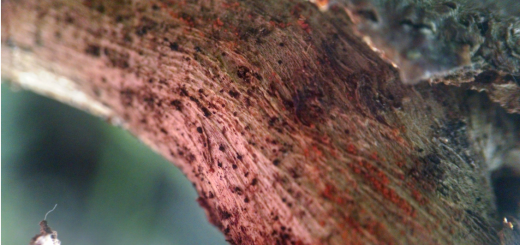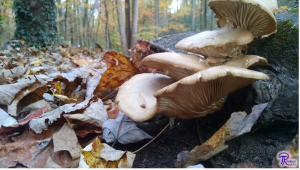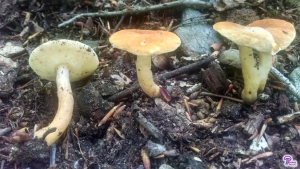#112: Monotropa uniflora, Ghost Plant, Indian Pipe, or Corpse Plant
On September 30, 1882, Emily Dickinson wrote the following in a letter to Mabel Loomis Todd:
That without suspecting it you should send me the preferred flower of life, seems almost supernatural, and the sweet glee that I felt at meeting it, I could confide to none—I still cherish the clutch with which I bore it from the ground when a wondering child, an unearthly booty, and maturity only enhances mystery, never decreases it—
The previous week, she had received a gift from Mabel Todd: a painting of Monotropa uniflora. These ethereal plants happened to rank among Emily Dickinson’s favorite wildflowers, thus prompting the response above. In the same letter, Dickinson gave Todd the poem “A Route of Evanescence” in return for the painting with a note explaining, “I cannot make an Indian Pipe but please accept a Humming Bird.” Many people have likened the Ghost Plant to the reclusive poet, so it seems fitting that Todd’s painting appeared on the cover of Poems – Dickinson’s first published book – which was released in November 1890, four years after Dickinson’s death.
Monotropa uniflora, the flower which so amazed the young Dickinson, is a very unusual plant. When they first see it, many people assume it is a mushroom because the Ghost Plant is so un-plant-like. It is closest to a candy cane in shape and coloration and closest to a fake aquarium plant in texture (more specifically, I’m thinking of the plant from Finding Nemo that was used to get Nemo out of the filter during the first escape attempt). While the plant may not look like a plant at first glance, closer examination will reveal small, translucent leaves and a flower with petals, anthers, a stigma, nectar, etc.
The vase- to cup-shaped flowers emerge from the ground in clusters, each flower facing downwards at the end of its own stalk. The stalk is straight except for one turn at the very top where the flower is attached, much as in a candy cane. As the flowers mature, they bend up to 90° (parallel to the ground) at most. This slightly downward-facing angle protects the pollen and nectar from rain but makes the flowers visible to pollinators. Small, scale-like leaves that are pure white – though often with blackened edges – adorn the stalk. The stalk and flower are usually pure white, but may have a pinkish tinge or, rarely, be bright red. Leaf edges and bruised areas quickly turn black and the entire structure dries out and turns black soon after being picked. The plant is fairly short: it usually grows to between 10 and 30cm (about 4-12in) tall.
After pollination, the flower straightens out to face the sky, the petals fall off, and the stalk and flower dry out and turn black. The dry stalk is fairly resilient and can be left standing for a long time. At the end of the stalk, the flower forms a spherical fruit. The dry, papery fruit contains many, small seeds that can fall out of the fruit through narrow, vertical slits. The slits close when wet, thereby protecting the seeds from rain. Once free of the fruit, the seeds are dispersed by the wind.
The Ghost Plant can be found in North America and parts of Asia. In North America, it grows everywhere except the tundra, southwestern deserts, central rocky mountains, and central great plains. The Ghost Plant prefers to grow in well-shaded areas with lots of trees and decaying matter, so it is no surprise that it cannot be found in the areas mentioned earlier. The Ghost Plant flowers from June through September, so keep an eye out for it next summer! There is one other species of Monotropa that can be found in North America: M. hypopithys. This plant can easily be distinguished from the Ghost Plant because M. hypopithys is more highly colored and produces multiple flowers on each stalk.
It is hardly surprising that this flower has so many names, since its unusual beauty is very hard to describe in a few short words. Even Emily Dickinson seems at a loss for words when describing M. uniflora in her correspondence with Mabel Todd. The plant’s scientific name, Monotropa (“once-turned”) uniflora (“one-flowered”), although accurate in its description of the flower’s structure, is almost too boring to do the plant justice. “Indian Pipe” also describes the plant’s structure, which is remarkably similar to that of a Native American tobacco pipe. “Ghost Plant” and “Corpse Plant” are much better at describing the overall appearance of the plant. Of these two names, “Ghost Plant” is much more common.
So why am I talking about a plant? Well, you may have noticed that this plant does not produce any green pigments. Without the green chlorophyll, the plant cannot produce its own food. This raises an important question: where does the plant get its food? It turns out that the Ghost Plant steals food from fungi!
Monotropa uniflora belongs to the subfamily Monotropoideae in the family Ericaceae (which includes blueberries, heathers, and azaleas, among others). All members of the Monotropoideae lack chlorophyll and are parasitic on fungi (“mycoheterotrophic”). To do this, these plants form special mycorrhizae called “monotropoid mycorrhizae.” In ideal mycorrhizal relationships, the plant gives the fungus sugars in exchange for nutrients like nitrogen and phosphorous. In monotropoid mycorrhizae, however, the plant takes sugar from the fungus and gives it nothing in return. To form these mycorrhizae, the plant must provide actively growing roots. Therefore, the main body of a Monotropoideae plant is composed of an underground system of tightly-packed, highly-branched roots. The root system is perennial, so the flowers can appear in the same place year after year.
The fungi involved in Ghost Plant mycorrhizae belong to the genera Russula and Lactarius. These mushroom-forming fungi are ectomycorrhizal with various trees. Therefore, the ultimate source of sugar for the Ghost Plant is a nearby tree: the Ghost Plant gets all its sugar from a fungus, which gets all its sugar from a tree. Oaks, pines, and beeches are all excellent hosts for Russula and Lactarius species, so you can find the Ghost Plant in a variety of different forest types.
How do we know carbon is transported in this manner? Mostly through studies using radioactive carbon. A bag containing radioactive carbon dioxide (where each carbon atom in the CO2 molecule is the radioactive isotope carbon-14) is placed around a tree branch. The leaves absorb the CO2 and incorporate the carbon into sugar molecules. These sugars are then transported all around the plant. Some of these molecules are given to mycorrhizal fungi, so radiation can be detected in nearby fungal cells and mushrooms. Radiation also shows up in nearby Ghost Plants, indicating that they received carbon from the fungus. This all happens fairly quickly (for example, over the course of a single summer), so the radioactive carbon could not have been absorbed from decaying matter such as fallen leaves.
See Further:
http://www.fs.fed.us/wildflowers/beauty/mycotrophic/monotropa_uniflora.shtml
http://botit.botany.wisc.edu/toms_fungi/oct2002.html
http://botany.org/Parasitic_Plants/Monotropa_uniflora.php
http://www.fcps.edu/islandcreekes/ecology/indian_pipe.htm
http://www.npr.org/templates/story/story.php?storyId=90106710
https://www.amherst.edu/library/archives/fileuploads?page=10 (Scroll down for Mabel Loomis Todd’s painting of Indian Pipes)








![#011: Characteristics of Kingdom Fungi [Archived]](https://www.fungusfactfriday.com/wp-content/themes/hueman/assets/front/img/thumb-small-empty.png)


